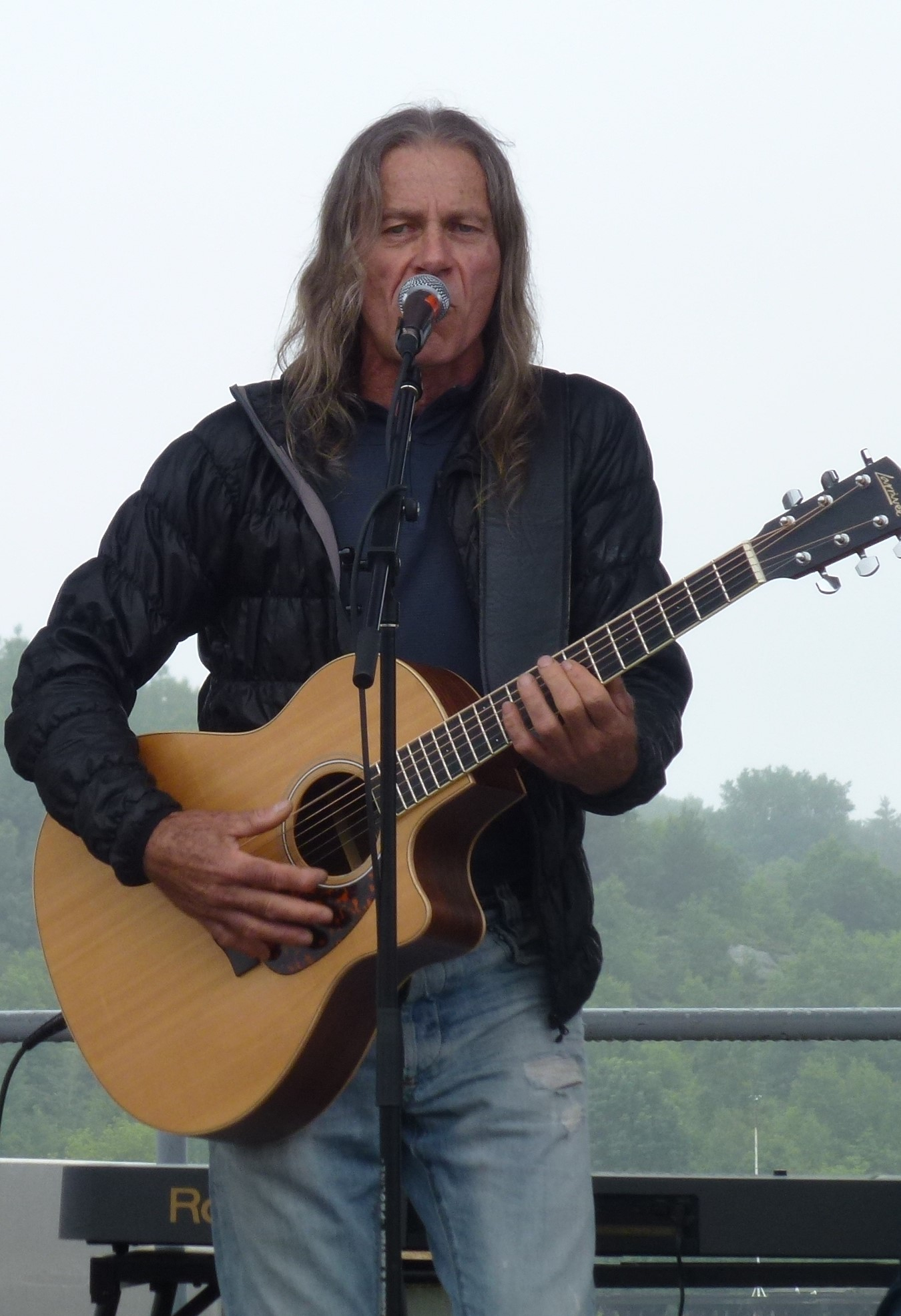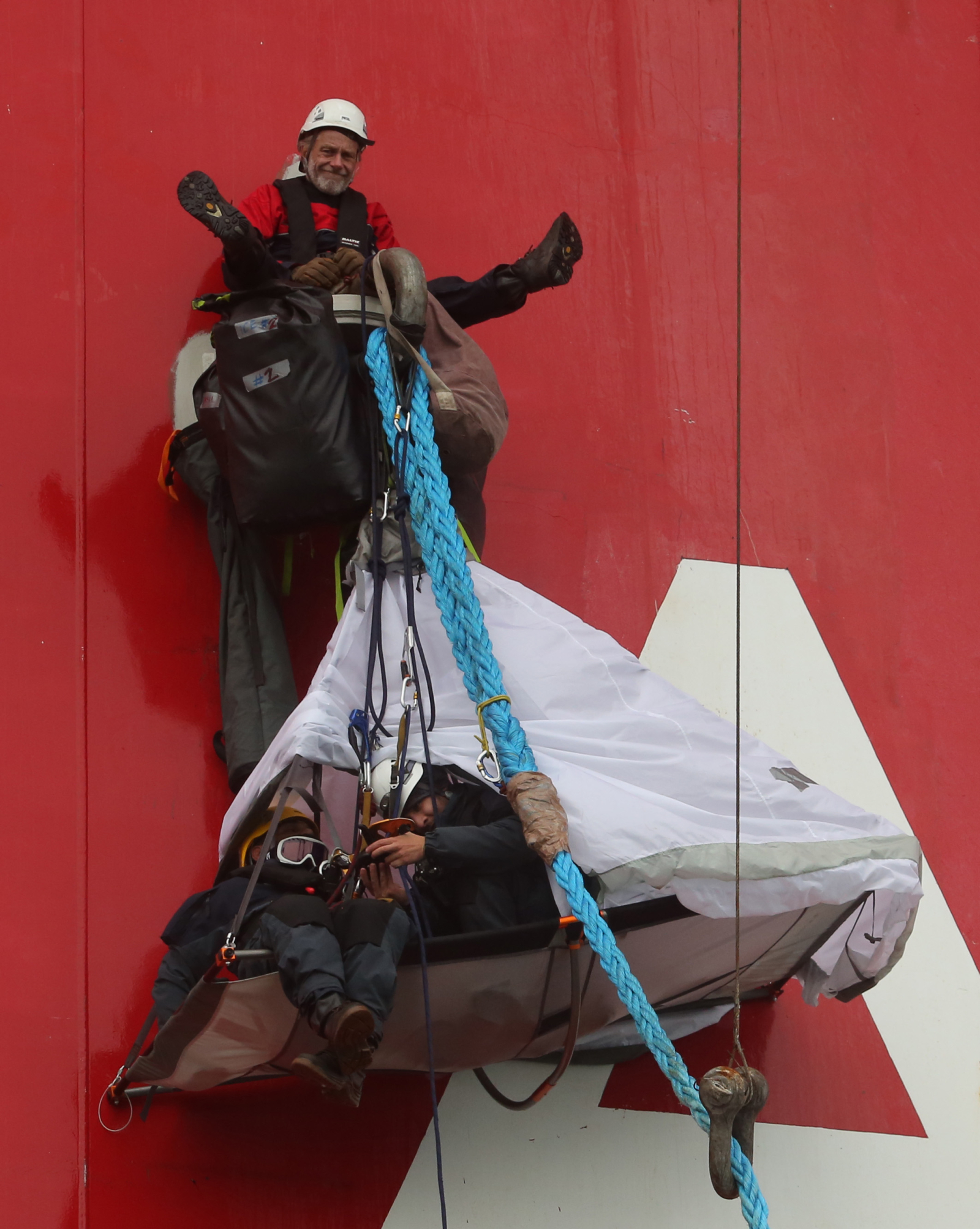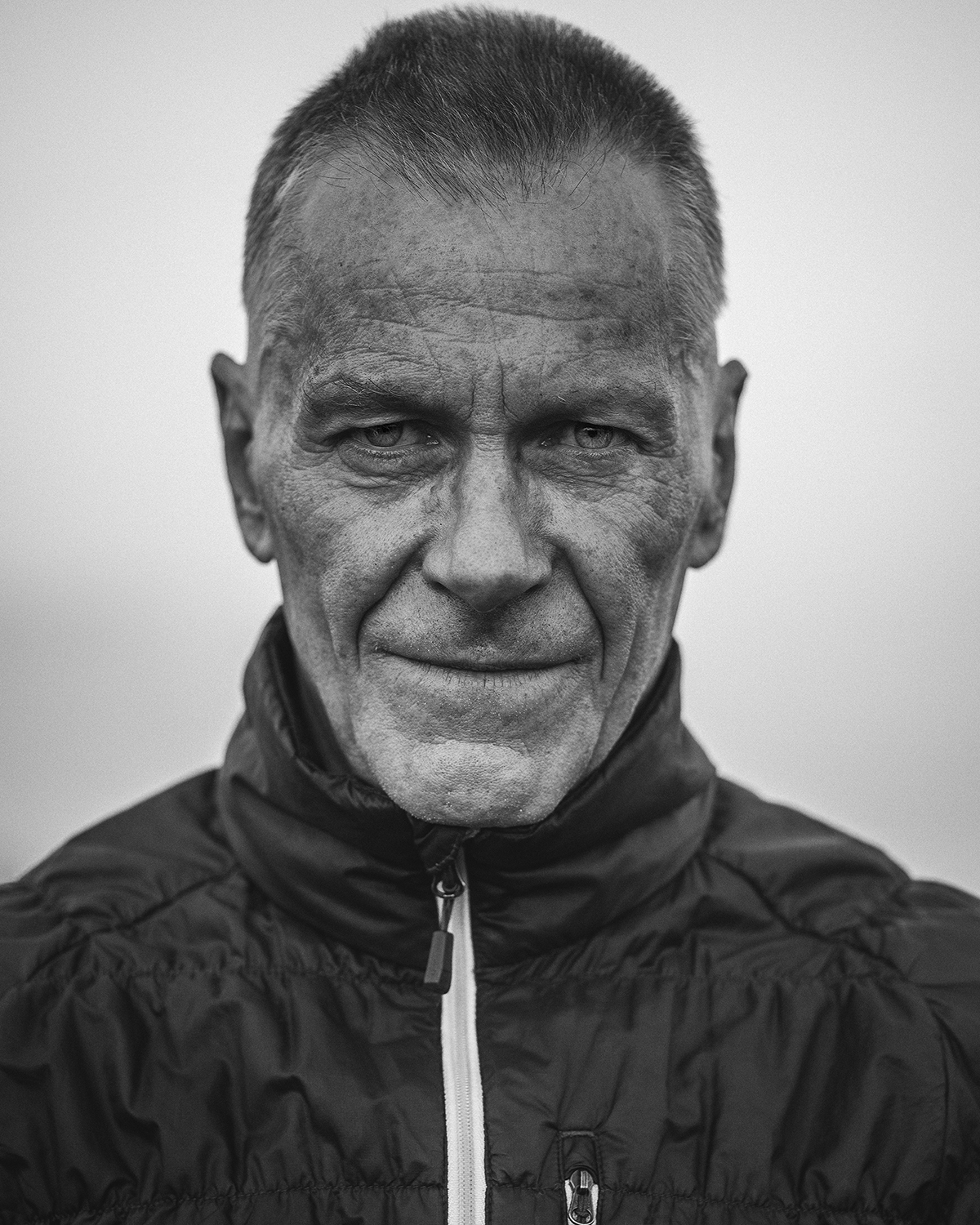The day Terry Christenson jumped the Trans Mountain work site security fence he wore a camera on his head. As the camera scanned the leaves on the ground, Christenson announced in a crisp voice, “This is Tango Charlie for the Coast Salish People.”
Tango Charlie, Christenson explained later in an interview from prison, is his alter-ego, the protester. He and a friend thought his story would make a good two-person play, so they created a second personality. Christenson is one character. The other is Tango Charlie, who is “a bit of a loose cannon, not a violent person, but someone that will mess with you, push the buttons,” Christenson said.
Terry Christenson is 72 years old, a climate change activist, and in jail. He received his last sentence on Nov. 20. But it wasn’t his first. And that’s because he says he would rather face jail time than allow the expansion of the Trans Mountain pipeline.
Christenson’s tactic is to take a “last stand” approach to climate action. And for that he is currently serving the longest sentence given to any activist protesting the pipeline expansion in British Columbia, and one of the longest given to any activist ever in British Columbia.
It’s a style Tzeporah Berman, the international program director of Stand.earth, supports. “There are moments throughout history when our governments fail us,” she said, “when they are more influenced by those who stand to benefit from maintaining the status quo, like the oil companies who want to expand production and build new pipelines. It’s in those moments that we are called to stand up. In the future, we’ll look back on this moment in history and people like Terry will be seen as heroes.”
Christenson’s trial
On Nov. 20 in B.C. Supreme Court, Christenson’s supporters, totalling around 20, clustered in the front of the spectator area. They were predominantly gray-haired. Many dressed in patterned, brightly coloured shirts and thick woolly sweaters. Jim Leyden, Burnaby Mountain’s Traditional Coast Salish Watch House Elder, was in attendance, as was Elan Ross Gibson, a Burnaby resident and member of BROKE (Burnaby Residents Opposing Kinder Morgan Expansion). They’d come for Christenson’s fourth criminal trial for non-violent action since March 2018.
When Christenson entered the courtroom his light blue eyes scanned the crowd. Small in stature, he was thin from his hunger strike. His gray hair was long and stringy. His back was slightly bent. He looked shaken.
A new justice was to preside and the activists wondered if this judge would be more sympathetic than the previous justice, Justice Kenneth Affleck, who had decided many of the more than 230 past convictions of pipeline protesters.
Justice Shelley Fitzpatrick entered the courtroom. She turned her gaze first to Christenson, who was representing himself for the alleged violation of a Trans Mountain injunction, then to the men in black gowns, the Crown lawyers prosecuting the case against him.
The Crown alleged Christenson committed two counts of criminal contempt on Oct. 24: obstructing or impeding Trans Mountain pipeline construction and breaching an injunction by crossing the five-metre property line as marked by Trans Mountain.
No one could deny Christenson’s actions. He captured them himself and posted a video on his Facebook page. With a camera attached to his head, he climbed over a high, barbed-wire fence and entered the Burnaby Work Terminal, a.k.a. the “tank farm,” cutting his hand as he leapt to the ground. He then walked into the work site and unfurled his banner that read “NO TANKS OR TANKERS.” A friend, standing on the platform Christenson constructed on Burnaby property that overlooked the worksite, took some photos. Christenson was soon under arrest.
Christenson pled not guilty to the charges. Like many Indigenous activists, he believes settlers’ laws on unceded territory are not legitimate. “We have federal law. We have provincial law. We need Indigenous law,” he said. “I’m working closely with the Coast Salish People … they gave me permission to do this.”
The sentencing
Though the Crown recommended six months, the judge sentenced Christenson to five months concurrent for criminal contempt of court. Because it’s concurrent, Christenson would spend the holidays in jail. But he guessed he would be released in mid-February 2020. “I should be home for Valentine’s Day,” he said. Home is Parry Sound, Ont.
Lingering outside the courtroom under the massive glass-covered atrium was a Trans Mountain security representative, who’d come from Calgary. When asked why Christenson’s actions are considered criminal, he looked confused, but then explained that Christenson disrupted their work and it wasn’t safe. Then he added that if Christenson isn’t in jail, he will keep coming back.
Christenson, who is Métis, considers himself blessed. He has two grown kids and two grandchildren. He said he had great parents and grew up on a five-generation homestead. A child of the 1960s, he was out on the streets protesting when he was young. He’s always worked hard, he said, starting out on a sawmill farm.

From the age of 18 to the age of 40, Christenson was on the road as a Juno-nominated guitarist. He’s also a world-class climber, and has designed climbing ropes and other climbing infrastructure for cities and companies. In 2006, he joined Greenpeace and five years later took part in the action against the first offshore rig-build in ice-covered Arctic waters. Christenson and other protesters boarded a Russian oil tanker and set up a bivy tent, disrupting the crew’s work. But the Russians soon turned water pumps on them and destroyed their tent. They were held 48 hours and let go. Later, Greenpeace would re-enact this action in what became the famous Arctic 30, named for the 30 protesters who were arrested and jailed for two months.
But Christenson became discouraged by Greenpeace: “I got really frustrated and decided I was just going to do it on my own.”
He turned his focus on Canada and “infiltrating industry.”
While some of Christenson’s acts are solo, Berman said, he is not alone. “When Terry first arrived in British Columbia, one of the first things he did was to reach out to Indigenous leaders and environmental leaders on Trans Mountain to make sure that anything he was planning was supportive of other efforts,” she said.
He draws strength from Indigenous leaders and culture, and considers fighting for the land to be equivalent to fighting for justice for Indigenous people.
“Canadians are known around the world as peacekeepers, and Indigenous people don’t have any peace,” Christenson said. “Everything in Indigenous culture is land and water and air. We can learn from that. Building this pipeline and thinking we can meet our obligations in 2030 is ludicrous.
“I just feel at this point in my life, I need to do this," he said.
History of protest actions
“If you would consider that the eagle is the messenger to Coast Salish people, that the land the tree grows from has not been ceded, then you begin to understand,” Christenson wrote on his website.
When Trans Mountain decided to chop down a tree that held eagle nests, Christenson’s protests on Burnaby Mountain began. He joined 100 other protesters in April 2018 and, employing his unique climbing talents, he made his first statement. The eagle tree was slippery, so instead of climbing it, he scaled a giant Cottonwood tree overlooking the Trans Mountain tank farm.

Like many others, he was arrested, spent a night in Deer Lake RCMP Detachment and was released on bail. When he left, he had no intention of paying his $2,000 fine.
A couple of weeks later, at 3:30 a.m. with a 20-kilogram backpack, he headed nearly 30 metres up another tree, set up a hammock and spent the night again overlooking the tank farm, with a banner reading “STOP KM” dangling from the tree. (Kinder Morgan still owned the pipeline at this point.) By the time he was arrested and reached the Deer Lake RCMP Detachment, he was weak and exhausted. He hadn’t eaten for three days. Charged with two counts of obstructing justice for climbing the eagle tree, the tank farm tree, and not paying his $2,000 fine, he was released on $1,000 bail.
He went home for several months, where he says he trained for his next action. This time his planned protest involved swimming to the Westridge Marine Terminal in Burnaby from “the port hole” where the tarsands oil would come out of the mountain to the tanker terminal. In a wetsuit on a rainy night, he swam for two hours until 3:15 a.m., when he shocked a Trans Mountain security guard. “My movement nudged the patrol boat, and instantly a large security officer sat up to attention, absolutely horrified at seeing me that close to him,” wrote Christenson on his website. “Holy F---! What are you doing?”
Christenson was taken to Deer Lake RCMP again, and faced Justice Affleck for a third time. Aflleck was going to let him go for $1,000 bail but Christenson's trial for the eagle deterrent and tank farm injunctions was coming up in a 12 days, so Christenson wouldn't sign the release to leave and was returned to jail. He was sent to North Fraser Pretrial. That’s where he started his first hunger strike, an act of protest for his being jailed. At that point, he was put in segregation, where his health, both physical and mental, could be closely monitored.
By the time he was transported to his trial in the B.C. Supreme Court, he was 20 pounds lighter, hypothermic, shaking, dizzy and so weak he could barely walk. This time, Affleck was less forgiving and slammed him with $3,000 bail. A lawyer stepped in, pointing out Christenson’s weakened state, and Christenson was released and allowed to go home.
His trial date for the eagle deterrent and swim actions was set for Oct. 25. But, on the day before his court date, he jumped the Trans Mountain security fence as Tango Charlie and entered the Trans Mountain worksite. He was taken into custody. Back in jail for the second time he started his hunger strike again. He has been in jail, on a hunger strike, ever since.
A day in the life
Like any prisoner’s, Christenson’s days are routine. He’s serving his time in a unique Fraser Regional Correctional Centre called November House. It opened in 2008 to house non-violent, open-custody individuals who are not at risk of escaping.
A guard wakes Christenson at 7 a.m. in a cell he has to himself. The facility houses on average 25 to 30 inmates, Breakfast is at 7:30 a.m. Christenson is popular at mealtime. Since he’s on a hunger strike he gives away most of his food. He has promised not to “fall on the knife” or become as weak as he did before, eating a slice of bread with a little peanut butter for breakfast, maybe with mustard for lunch and ketchup for dinner, but mostly he’s on a liquid diet. Bread satisfies his hunger for about 30 minutes, he said, but for the other 21 hours of the day, he’s hungry.
When he was in segregation at North Fraser Pretrial Centre in Port Coquitlam, Christenson was only given limited liquids, but at November House he can have all the juice, milk and broth he wants.
“Mahatma Gandhi said power is not a fact, it’s an effect,” he said, explaining his decision to go on hunger strike. “And the effect is that you have no power over me. I am a free man.”
By 8:30 a.m., Christenson and the other inmates are prepped for whatever work they will do that day. One day, they wash and dry fire shelter tents for firefighters. Another day, they weed and rake the grounds. On yet another day, they move tables and chairs in a large auditorium for a Christmas event for underprivileged youth.

The workday ends at 2 p.m. and Christenson heads to the shower. Then he writes. He’s thinking of writing a book with a professor in Victoria. He is free to walk the grounds, visit the library, weight room, movie room or sweat lodge. He can make phone calls whenever he likes.
“It’s an inmate commune,” Christenson said. “This place is brilliant. It’s truly corrections as opposed to prison or jail.” Cell walls are made of drywall, not cement. Guards mentor young inmates. Counselling is available. Someone even comes to perform smudges, he said.
And Christenson teaches guitar. The supervisor purchased two Yamaha guitars for that very purpose.
He hopes his experience at November House might dispel some fears about incarceration and inspire more strident activism.
“Can you imagine if 200 or 300 young students from SFU decided just to walk within the five-metre injunction zone? How it would clog up the system and be really effective,” Christenson speculated. "If enough people go to jail," he said, "then the courts will have to think about what’s going on."
‘Watch out, Doug Ford’
“I could hear him doing a live radio show (from the tree) and he was so articulate about why he was up there … and he was very humble. I remember him saying something like, this is nothing compared to what my grandchildren will be facing if we don’t act now on climate change,” Berman said.
The security representative from Trans Mountain who attended Christenson’s trial was right when he said, “he’ll just come back.” Christenson has no intention of stopping.
”It’s a war, albeit a peaceful war,” he said. “And their whole thing about sentencing to discourage me or whatever … I even told them that if I get out, I'm going to go home, heal up, visit the family. But things haven't changed. I’ll come back. They can't deter me.”
The five-month sentence started Oct. 25, and even though it’s concurrent, and a third of the sentence is taken off for good behaviour, he won’t be out until Feb. 20, 2020. That means no Valentine’s Day at home, as he had hoped.
He has a plan in place for when he is released, a new action for Ontario.
“Watch out, Doug Ford,” he warned. "This target is national and I can actually seize (it) by climbing.”
People like Terry are already
People like Terry are already heroes. Thank you Terry and everyone else who has taken a stand against the our destructive government who represents corporate greed rather than the common good.
https://www.penderpod.ca/sinister-seniors
I am heartened by this
I am heartened by this Extinction Rebellion type of action. a commitment to get arrested in a mass way by those who can do it without great suffering to themselves or their family is the next step. one off people are showing the idea but group arrest I think is more disruptive
I will watch for how to add my voice to Terry's action against DOFO AND THE DESTROYERS here in complacent Ontariario. How about we organize reacting to the tearing down of the wind farms with a human chain blockade. a protest at the site burying nuclear waste on the edge of Lake Huron. protesting the ripping out ev charging stations at go terminal??
So much crazy assed Panic in the oil lobby trying to dial us back to 1950 thinking and holding back the inevitable changes that are coming whether they wish it or not. Sadly there is no way they can hold back the fires floods and droughts!



Comments